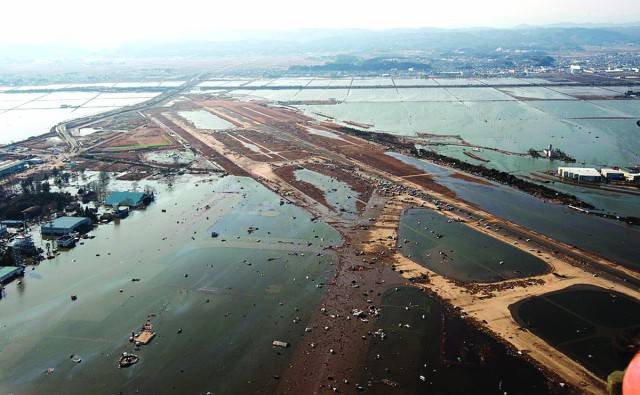
This photograph shows a tsunami flooding the Sendai Airport runway after the 2011 earthquake in Japan on March 11. The undersea earthquake had an epicenter east of the Oshika Peninsula of Tohoku.
This was the most powerful earthquake ever recorded in Japan, and the fourth most powerful earthquake in the world since modern record-keeping began in 1900. The earthquake triggered powerful tsunami waves that may have reached heights of up to 133 feet in Miyako in Tōhoku’s Iwate Prefecture and which, in the Sendai area, traveled at 700 km/h.
Residents of Sendai had only eight to ten minutes of warning, and more than a hundred evacuation sites were washed away. The tsunami swept the Japanese mainland and killed over 15,000 people, mainly through drowning, though blunt trauma also caused many deaths. The latest report from the Japanese National Police Agency report confirms 15,899 deaths, 6,157 injured, and 2,529 people missing across 20 prefectures, and a report from 2015 indicated 228,863 people were still living away from their home in either temporary housing or due to permanent relocation.
The tsunami caused nuclear accidents, primarily the level 7 meltdowns at three reactors in the Fukushima Daiichi Nuclear Power Plant complex, and the associated evacuation zones affecting hundreds of thousands of residents. Many electrical generators ran out of fuel. The loss of electrical power halted cooling systems, causing heat to build up. The heat build-up caused the generation of hydrogen gas. Without ventilation, gas accumulated within the reactor containment structures and eventually exploded. Residents within a 20km radius of the Fukushima Daiichi Nuclear Power Plant and a 10 km radius of the Fukushima Daini Nuclear Power Plant were evacuated.

This was the most powerful earthquake ever recorded in Japan, and the fourth most powerful earthquake in the world since modern record-keeping began in 1900. The earthquake triggered powerful tsunami waves that may have reached heights of up to 133 feet in Miyako in Tōhoku’s Iwate Prefecture and which, in the Sendai area, traveled at 700 km/h.
Residents of Sendai had only eight to ten minutes of warning, and more than a hundred evacuation sites were washed away. The tsunami swept the Japanese mainland and killed over 15,000 people, mainly through drowning, though blunt trauma also caused many deaths. The latest report from the Japanese National Police Agency report confirms 15,899 deaths, 6,157 injured, and 2,529 people missing across 20 prefectures, and a report from 2015 indicated 228,863 people were still living away from their home in either temporary housing or due to permanent relocation.
The tsunami caused nuclear accidents, primarily the level 7 meltdowns at three reactors in the Fukushima Daiichi Nuclear Power Plant complex, and the associated evacuation zones affecting hundreds of thousands of residents. Many electrical generators ran out of fuel. The loss of electrical power halted cooling systems, causing heat to build up. The heat build-up caused the generation of hydrogen gas. Without ventilation, gas accumulated within the reactor containment structures and eventually exploded. Residents within a 20km radius of the Fukushima Daiichi Nuclear Power Plant and a 10 km radius of the Fukushima Daini Nuclear Power Plant were evacuated.


